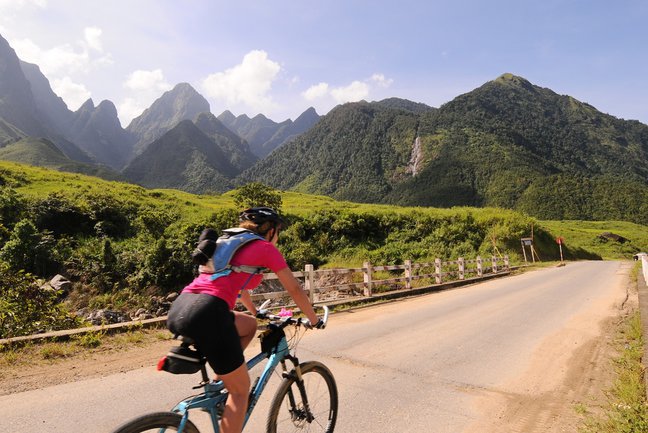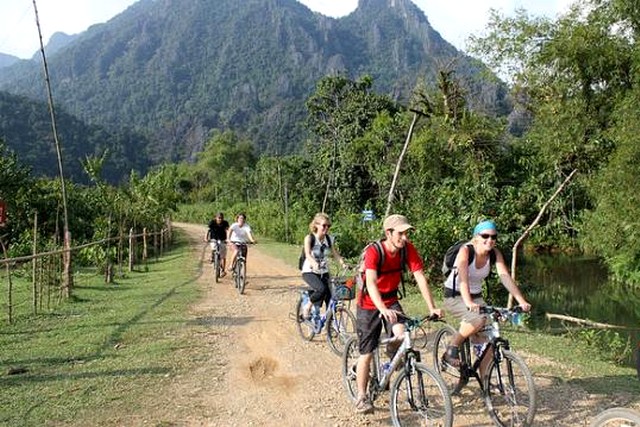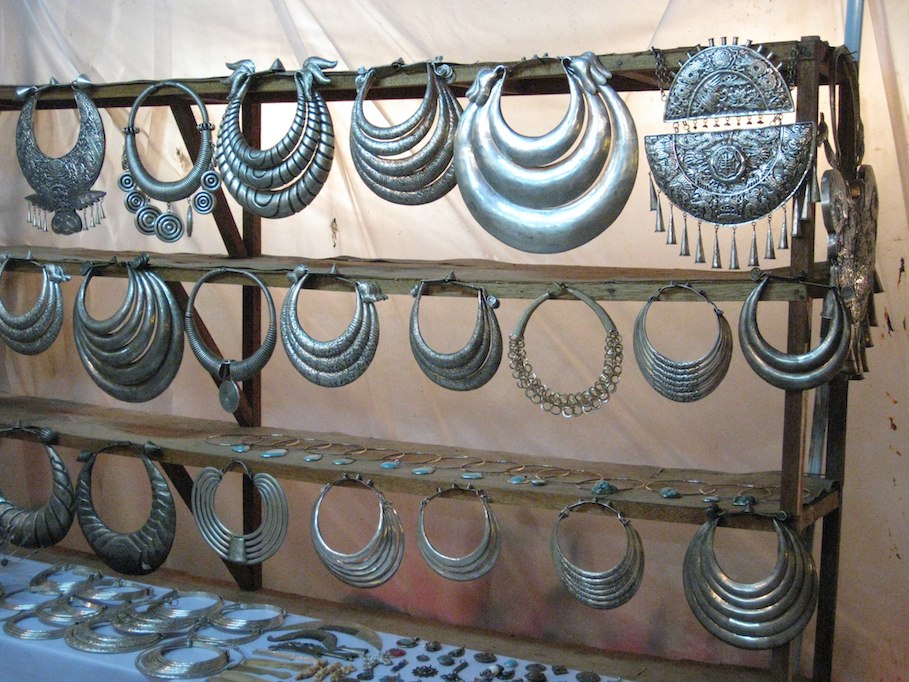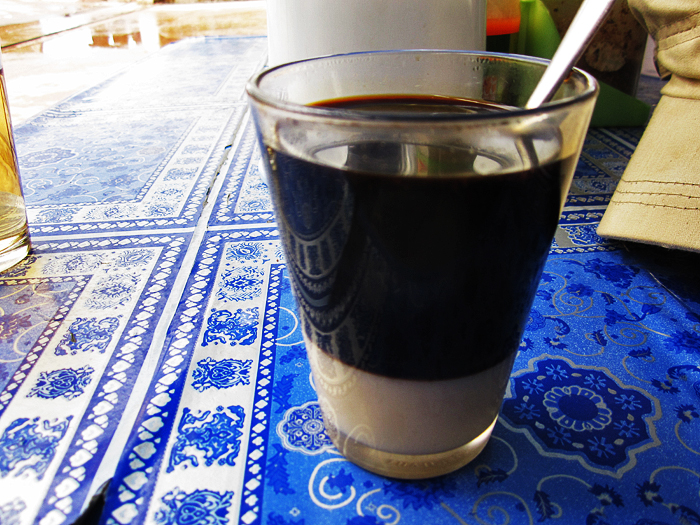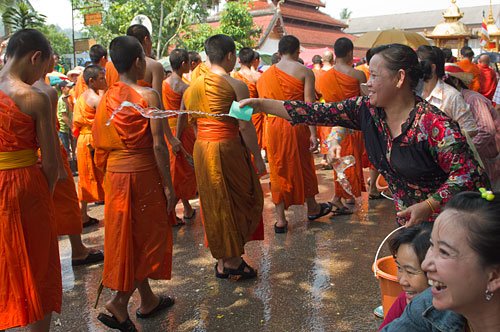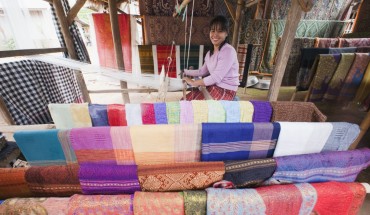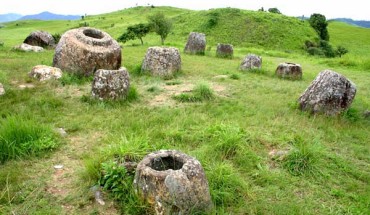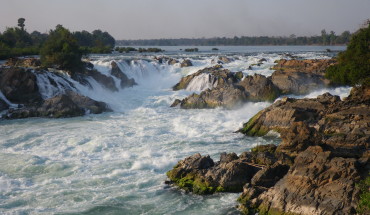PLAINNING
When to Ride
The best overall time for visiting most of Laos is between the months of November and March, when it rains least and is not too hot. If you plan on focusing on the mountainous northern provinces, the early rainy season – say May to July – is not bad either, as temperatures are moderate at higher elevations, although the roads can quickly take on the appearance of small rivers in places.
Maps
Accurate maps with a scale designed for cycle touring are rare for Laos, but in most cases the sheer lack of roads makes navigation relatively straightforward. Lonely Planet’s Thailand, Vietnam, Laos & Cambodia Road Atlas should prove sufficient for most purposes. For tours not covered in this book, you could purchase a 1500,000 scale map from the National Geographic Service in Vientiane, north of the Patuxai monument. However, most of the maps are quite old.
What to Bring
For the full story on the cycling gear required, see the Regional Facts for the Cyclist chapter. Blackouts are common during the rainy season, so it’s a good idea to bring a torch (flashlight).
Most consumer goods in Laos are imported from Thailand or Vietnam, so unless you’re in a really remote area (beyond the rides in this chapter), it is always possible to pick up the basics as you go.
Warning
Outside the Mekong River valley (stretching from Bokeo province to Champasak province), road conditions and vehicle maintenance are quite substandard; it might take days to reach a hospital in the event of an accident. The risk of breakdowns and accidents is moderate to high, though increasing traffic means better odds of quicker assistance.
Cyclists must also be aware of certain trouble spots (such as Rte 13 north of Kasi to Luang Prabang on the Northern Wonders ride) and the extremely dangerous nature of UXOs (unexploded ordnance, such as bombs or mines). See Touring Dangers & Annoyances in the Health & Safety chapter for more UXO information, and for advice on avoiding/ handling an emergency situation on the road.
ACTIVITIES
Hiking & Trekking
Laos’ mountainous, well-forested geography makes it a potentially ideal destination for hikers. All 13 provinces have hiking possibilities, in particular the 17 National Biodiversity and Conservation Areas (NBCAs) should be rewarding territory. Day trips are generally acceptable but authorities view overnight trips that involve camping or staying in villages with suspicion.
See Touring Dangers & Annoyances in the Health & Safety chapter for precautions to take against Unexploded Ordnance (UXOs).
Shopping
Laos’ ethnic diversity fosters various silver- works, woodcarving, tribal crafts, ceramics, rattan furniture, textiles and handmade saa (mulberry bark) paper, nearly all of which can be bought in Vientiane.
North-eastern Laos is famous for Sam Neua-style textiles, which feature rich brocade and dazzling colors. Simple Lao- style cotton fabrics are abundant near Pakse feature unique Mon-Khmer weaving.
Hill-tribe crafts and jewellery are most abundantly available in Vientiane, though very interesting work can be found in Luang Prabang, Luang Nam Tha, Phongsali, Hua Phan, Bokeo, Salavan, Sekong and Attapeu.
Most shops now have fixed prices but you can still bargain for fabrics, carvings, antiques and jewellery.
ACCOMMODATION
Tourist hotels are typically priced in US dollars, while guesthouses and less expensive business hotels (common in Huay Xai, Luang Prabang, Savannakhet and Pakse)
Outside the Mekong River valley, most provincial capitals have only two or three basic hotels or guesthouses, although the number and quality of places to stay seems to be increasing every year.
Bikes are generally not allowed in hotel or guesthouse rooms but proprietors are usually happy to show you somewhere suit- able to lock up. Although it always pays to lock up when leaving your bike unattended, the risk of theft in Laos is relatively low.
FOOD
Lao cuisine is very similar to Thai in many ways. In rural areas wild rather than domes- tic animals – especially deer, wild pig, squirrels, civets, monitor lizards, jungle fowls/ pheasants, dhole (wild dog), rats and birds – provide most of the meat. For more specific advice on your day-to-day nutritional needs during touring, see Nutrition in the Health & Safety chapter.
Food is salted with naam paa, a thin sauce of fermented anchovies (usually imported from Thailand), and Paa daek; a coarser Lao preparation made from fermented freshwater fish, rice husks and rice ‘dust’. Common seasonings include the gal in gale root ground peanuts (more often a condiment), hot chilies tamarind juice ginger and coconut milk Chilies are sometimes served on the side in hot pepper sauces called jaew. Phong suu lot – ajinomoto or MSG – is also a common seasoning, and in Laos you may even see it served as a table condiment in noodle restaurants. In Luang Prabang, dried water-buffalo skin (ruing khwai haeng ) is a popular ingredient.
All meals are eaten with rice or noodles. Glutinous rice is the preferred variety, although ordinary white rice is also common. Sticky rice is eaten with the hands. Khao jao is eaten with a fork and spoon. Noodles may be eaten with fork and spoon or chopsticks. The most common noodles in Laos are foe (rice-noodle soup) and khao pan (thin, white wheat noodles).
The closest thing to a national dish is laap, a spicy beef, duck, fish or chicken salad made with fresh lime juice, mint leaves, onions and lots of chilies. It can be hot or mild depending on the cook.
In Vientiane, Luang Prabang and Savannakhet, French bread is a popular breakfast food. Sometimes it’s eaten plain with kaafae nom hawn (hot coffee with milk), sometimes it’s eaten with eggs (khai). Croissants and other pastries are also available in Vientiane bakeries.
DRINKS
Nonalcoholic Drinks
Water purified for drinking purposes is simply called drinking water, whether boiled or filtered. All water offered in restaurants or hotels will be purified.
Lao-grown coffee is one of the world’s best. The usual brewed coffee is served with sugar and sweetened condensed milk – if you don’t want either, specify black coffee followed with without sugar. Iced coffee is also common.
Saa hawn (hot tea) is usually available in the same places real coffee is. Again, specify beforehand if you don’t want milk or sugar. Chinese-style (green or semi-cured) tea is the usual ingredient in naam sda, the weak, often lukewarm tea traditionally served free in restaurants.
Fruit drinks, smoothies and sugar cane drinks (see the boxed text ‘Power on with the Sugar Cane’ in the Vietnam chapter) are often found along the tourist trail. In the bulk of small villages not on the main tourist trail the main drinks on offer are bottled water, hot tea, bottled soft drinks and beer.
Alcoholic Drinks
Beer The Lao Brewery Co produces the very drinkable Bia Lao (or ‘Beer Lao’, sometimes spelt ‘Beerlao”), one of Asia’s finest. A draught version (bia sot, or ‘fresh beer’) is available only in Vientiane beer bars in and like all Beer Lao contains 5% alcohol. Imported Heineken and Tiger beer are also available in cans.
Distilled Spirits Rice whisky, or Lao liquor, is a popular drink among lowland Lao. Strictly speaking, lao-lao is not legal but no one seems to care. It’s usuallydrunk neat, with a plain water chaser.
In rural provinces, a weaker version of lao-lao known as jar liquor is fermented by households or villages. Lao hai is usually drunk from a communal jar using long reed straws. It’s not always safe to drink, since uncoiled water is often added.
TRAVEL RESTRICTIONS
In March 1994 travel permits were abolished; foreigners (and Laos) are now theoretically free to travel throughout most of the country.
In ‘remote’ provinces such as Sekong, Attapeu and Hua Phan, travelers may meet officials who bar entry. We don’t advise arguing with people who have the power to incarcerate you indefinitely without trial.
RADIO & TV
Laos has one radio station, Lao National Radio. English-language news is broadcast twice daily but most expats prefer the news on the usual short-wave radio programmers.
Lao National Television sponsors two channels which can only be received in the Mekong River valley and broadcast only from 7 to 11 pm. Most Lao watch Thai TV, which can be received anywhere in the
Mekong River valley. Satellite TV broadcasts international, as well as Asian content.
PHOTOGRAPHY
Restrictions
Lao officials are sensitive about photography of airports and military installations; when in doubt refrain.
Photographing People
In rural areas people are often not used to having their photo taken, so be sure to smile and ask permission first. In tribal areas always ask permission before photographing people or religious totems; photography of people is taboo among several of the tribes.
WEIGHTS & MEASURES
While the international metric system is the official system in Laos, in rural areas distances are occasionally quoted in meun (12km). Gold and silver are sometimes weighed in boat.
LAUNDRY
Most guesthouses and hotels offer laundry services, which usually vary in price according to the cost of their rooms. The cheapest places are the small laundry shops found in bigger towns.
BUSINESS HOURS
Government offices are generally open from 8 to 11am and 2 to 5pm. Shops and private businesses open and close a bit later and either stay open during lunch or close for just an hour. As a guide, banks generally open from 8am to 3.30pm; post offices, 8am to 5pm; and shops and markets, 7am to 6pm. Many museums and wats close for lunch and on weekends.
This book details the opening hours of museums etc on side trips, or if they are a long ride out of town.
PUBLIC HOLIDAYS & SPECIAL EVENTS
The Lao Buddhist Era (BE) calendar figures year one as 638 BC (not 543 BC as in Cambodia), so 2000 AD is 2638 BE according to the Lao Buddhist calendar.
Festivals in Lao are mostly linked to agricultural seasons or historic Buddhist holidays. The general word for festival in Lao is bun (or boun).
Public holidays and the more noteworthy events in Laos include.
Some more links for Tour Vietnam Cambodia or Tour in Laos here.


